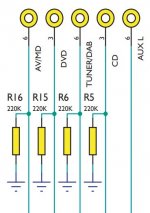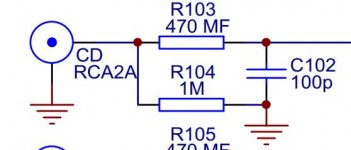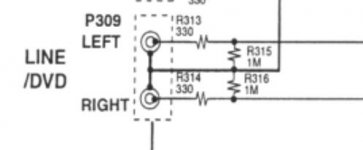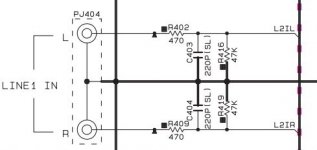Looking at several service manuals for commercial integrated amp and pre amps, I've noticed they use resistors and caps to ground at the RCA terminal. Some just have a resistor to ground where others have a cap and a resistor to ground and a few have a series resistor as well. 47K - 1M and 100pF - 220pF seems common when used from signal to ground.
I'm trying to find out what these are actually doing and why those values are chosen. I've built plenty of amps and pre amps but have never used these at the RCA. All either went straight to the power amp or switch or pot or buffer.
I thought it might have something to do if nothing is connected to the RCA input.
I've attached a few examples.
I'm trying to find out what these are actually doing and why those values are chosen. I've built plenty of amps and pre amps but have never used these at the RCA. All either went straight to the power amp or switch or pot or buffer.
I thought it might have something to do if nothing is connected to the RCA input.
I've attached a few examples.
Attachments
They bleed-off stray DC from a leaky source. This may reduce "pop" when switching from one input to another.
They become "essential" in guitar pedalboards. Pedals of dubious construction are swithed in/out many ways over the course of a set. Levels are lower than hi-fi line. And the "best" pedals are vintage, which means cheap caps long past their peak freshness (i.e. leaky).
In hi-fi a resistor there does about zero harm at negligible cost.
The cap is an attempt to bleed radio waves. It does little good without a series resistor. 470r and 100pFd (3MHz!!) does little good anyway.
They become "essential" in guitar pedalboards. Pedals of dubious construction are swithed in/out many ways over the course of a set. Levels are lower than hi-fi line. And the "best" pedals are vintage, which means cheap caps long past their peak freshness (i.e. leaky).
In hi-fi a resistor there does about zero harm at negligible cost.
The cap is an attempt to bleed radio waves. It does little good without a series resistor. 470r and 100pFd (3MHz!!) does little good anyway.
The cap is an attempt to bleed radio waves. It does little good without a series resistor. 470r and 100pFd (3MHz!!) does little good anyway.
They may do little good for AM band interference, but they're dandy for FM and cell phone interference. There's lots of life in the air above 3MHz these days LOL!
A number of consumer hifi outputs use what I feel is a ridiculously high output resistor, sometimes as big at 2K2Ω or more, and that makes it hard to design this sort of passive RF filter. Some equipment sensibly uses 50-100Ω, but then there is gear that uses 2K2Ω and even more, and an RFI filter will have to handle both cases. So, it's practically difficult to do anything truly meaningful at the AM band, especially with only a single stage, but it's still useful to do something, if only to handle cell phone interference.
If you have a proper RF layout, there are some capacitors that can be used that are ideal for cell phone rejection. The Murata GQM1875C2E101JB12D is an 0603 size 100pF cap designed for cell phone base amplifiers. The electrodes are sized to provide two resonant nulls, one at 850MHz and another around 1.85GHz, which is right on top of two important cell phone bands. This helps to keep losses from this cap lower in a transmitter, and also provides extra, free attenuation beyond the bulk capacitance in an RFI filter. Normal 100pF 0603 caps have self resonant frequencies around 600MHz, which isn't that useful, but this RF cap from Murata places these nulls where they can do something useful. So, it can be tough to use much more than 100pF for these filters, especially in the land of consumer hifi, but they do have important uses, and can be optimized for cell phone rejection if you're using a good RF layout already.
If you have a proper RF layout, there are some capacitors that can be used that are ideal for cell phone rejection. The Murata GQM1875C2E101JB12D is an 0603 size 100pF cap designed for cell phone base amplifiers. The electrodes are sized to provide two resonant nulls, one at 850MHz and another around 1.85GHz, which is right on top of two important cell phone bands. This helps to keep losses from this cap lower in a transmitter, and also provides extra, free attenuation beyond the bulk capacitance in an RFI filter. Normal 100pF 0603 caps have self resonant frequencies around 600MHz, which isn't that useful, but this RF cap from Murata places these nulls where they can do something useful. So, it can be tough to use much more than 100pF for these filters, especially in the land of consumer hifi, but they do have important uses, and can be optimized for cell phone rejection if you're using a good RF layout already.
- Status
- Not open for further replies.



